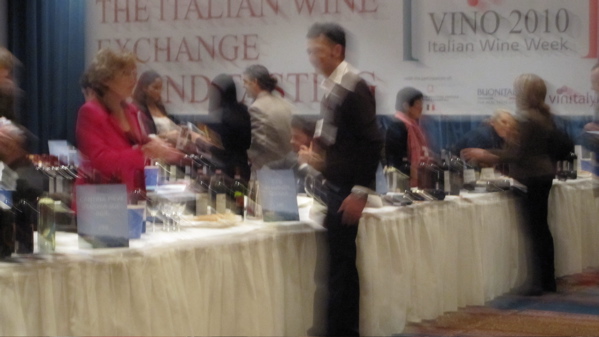The first thing I had to get straight after this Vino 2010 tasting event (at New York’s Waldorf-Astoria hotel) was
that Apulia and Puglia are actually the same place. I had
heard of Puglia, though not of Apulia, but turns out Apulia is just the English
version of Puglia. The region forms the “heel” of Italy’s
“boot” in the country’s SE.
The seminar’s moderator, Italian wine expert Charles Scicolone, noted that people often dismiss Puglia wines as “too jammy, pruney, and
lacking in acidity,” but most of the wines we tasted today proved
that perception wrong.
I learned there are three main grapes grown in Puglia:
negroamaro, primitivo and uva di troia, also known as nero di troia and often
combined with malvasia nera, which is used mainly as a blending grape.
We tasted 14 wines from Puglia – a bit much at 10 in the
morning, so there was a lot of spitting going on – but a good representation of
the mainly big, red wines that come out of this region.
We started with five uva di troias, all made 100 percent
from the grape except for one blended with montepulciano. Each had red fruits
and cherry on the nose, some with violets and earth and a slight aroma of
nutmeg or cinnamon. The tastes ranged from big red fruit and oak with a long
cherry finish (the 2006 Puglia I.G.T. “Villa Schinosa”) to very
vegetal with eggplants and violets (the 2006 Puglia I.GT. “Le Cruste”
Agricole Alberto Longo) to my favorite one, the 2007 Barletta D.O.C.
“Priamis” Cantina Sociale di Barletta with a taste of cherries and nutmeg and a slightly oaky and vegetal flavor. It was very drinkable and probably good
with pasta and meats (all I had with it were some dry crackers!).
Next we moved on to the three negroamaros, all using 100
percent of the grape and with really varied flavors. The first (the 2006
Salento I.G.T. “Aruco Rosso” Santi Dimitri) was quite vegetal on the
palate with flavors of earth, dried cherries and nutmeg; the second (the 2006
Salento I.G.T. “Nero di Velluto” Feudi di Guagnano) was higher in
tannins, though still with a flavor of cherry and nutmeg; and the third (the
2005 Salento I.G.T. “Piromafo” Valle Dell’Asso) had a fuller body
with meaty flavors and a touch of oak and earthiness. All were quite complex,
though I’m not sure I’d reach for any as an everyday drinking wine.
Finally we sampled the primitivos. I was the most excited
about these, especially since I love zinfandel, though I’d recently learned
that genetic studies have determined that primitivo and zinfandel are not the same grape (though this seems to be in some
dispute). I’ve actually not been a big fan of the few primivitos I’ve tried in
the past – they’ve seemed too high in alcohol and oak.
We tasted five primitivos, all aged in oak barrels except
for one – the 2008 Salento I.G.T. “Livurni” Vetrere, which apparently
was produced by two sisters, and was a nice smooth wine with tastes of
cherries, bananas and a touch of chocolate on the finish. I also enjoyed the
2006 Salento I.G.T. “Torcicoda” Tormaresca – though it had slightly
higher tannins and perhaps not as much taste of the terroir, it was nice and
smooth with cherry flavors and a nice chocolate finish. Another interesting
primitivo was the 2007 Primitivo di Manduria D.O.C. Poderi Angelini, which was
the only wine made of dried grapes. This gave a unique taste to the wine of
dried apricots and figs. Yum.
Not sure if this tasting session will influence my buying
habits, but I will at least be curious to try some other uva di troias if I see them in
the wine shop or on a restaurant list.
– by Liz Humphreys, Winederlust Eater in Chief


